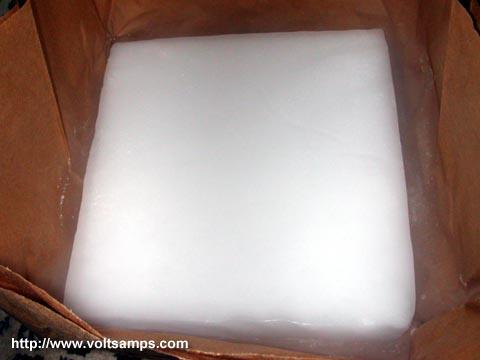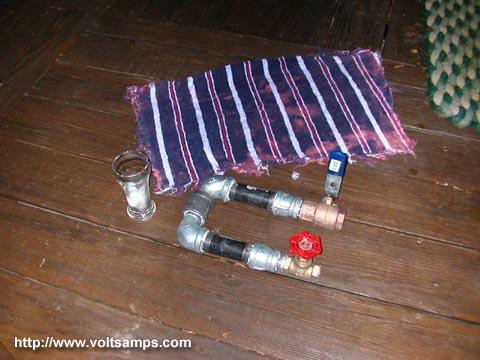 .:: Dry Ice Propulsion ::. .:: Dry Ice Propulsion ::.
|
Purpose:
This project demonstrates how dry ice can be used as a propellant for projectile firing pneumatic cannons. I will attempt to conclude how affective dry ice is as a propellant for projectiles. It is known that at room temperature dry ice becomes CO2 gas until around 800 PSI to 900 PSI. The benefit of using dry ice vs. an air compressor is that the recharge time is fast and multiple recharges are possible. One thing to keep in mind is that PVC is not meant to be pressurized at low temperatures thus a steel tank should be used with the PVC pneumatic cannon.
Materials:
- Dry Ice
- Water
- Pneumatic Cannon with a Brass Ball Valve
- Steel Pipe Dry Ice Chamber
- Pressure Gauge
Images:

As you examine the packaged block of dry ice which only costs $7 / 10lb you'll notice the warning on the side that advises the user not to store this substance in a closed container for obvious reasons. I will however ignore this warning since we can control the pressure buildup in the air storage chamber.

The dry ice lets off small amounts fog and CO2 vapors. However adding water to the dry ice yields much larger amounts of CO2.

One of these glasses of water is filled with water and the other with dry ice. Both will be dumped into the pneumatic cannon. The dry ice should go in first since it's the hardest to stuff in there, and then the water.

The pneumatic gun climbs slowly in pressure and stopped at 40 PSI. I was baffled by this and touched the dry ice chamber on the gun. As soon as the heat of my hand warmed it the pressure shot up to 200 PSI in a matter seconds. I was delighted :-). I fired the pneumatic and allowed it to climb back up to 200 PSI within the same time period as before. This time I heard subtle cracking sounds coming from the PVC and decided to stop while I still had all my body parts in tact. I should have taken my own advice and used a steel dry ice chamber as I suggested above.

After doing that experiment a thought popped into my mind and I had to try it. I always wondered if steel pipe was able to withstand 900 PSI. If it could, then this meant a whole new level of pneumatic cannons. I constructed a simple device to test the pipes fitting and valves. The ball valve was only rated for 500 PSI but I had faith in it. I dumped dry ice into the chamber and filled it with hot water. I then closed the ball valve and ran for my life. After about 10 minutes of no loud boom's I returned to the site of the chamber and released the ball valve. A huge jet of water shot out. The pipes, fitting and valves did indeed withstand the pressure although I never recommend others to exceed any ratings, so don't. Next step would be to try the same setup but with an actual pneumatic cannon and fire at 900 PSI!
|
 |
|



